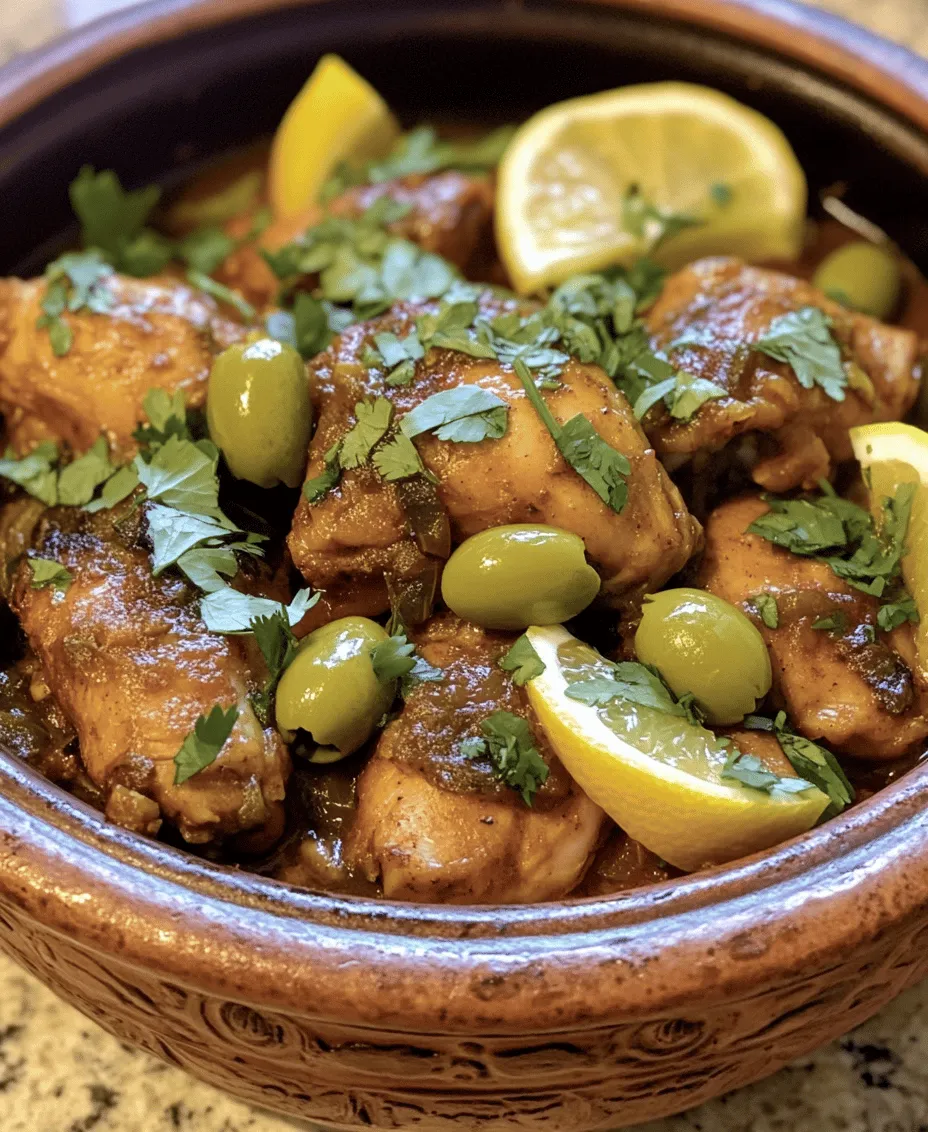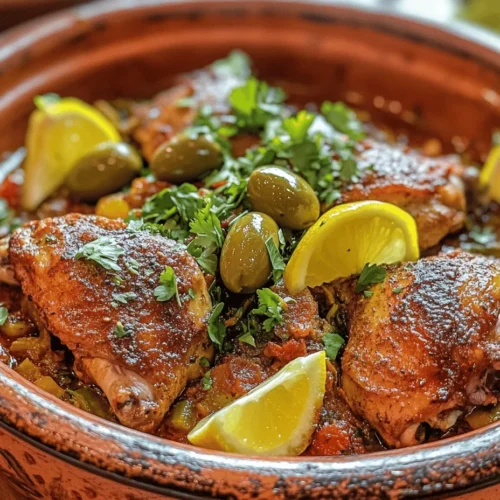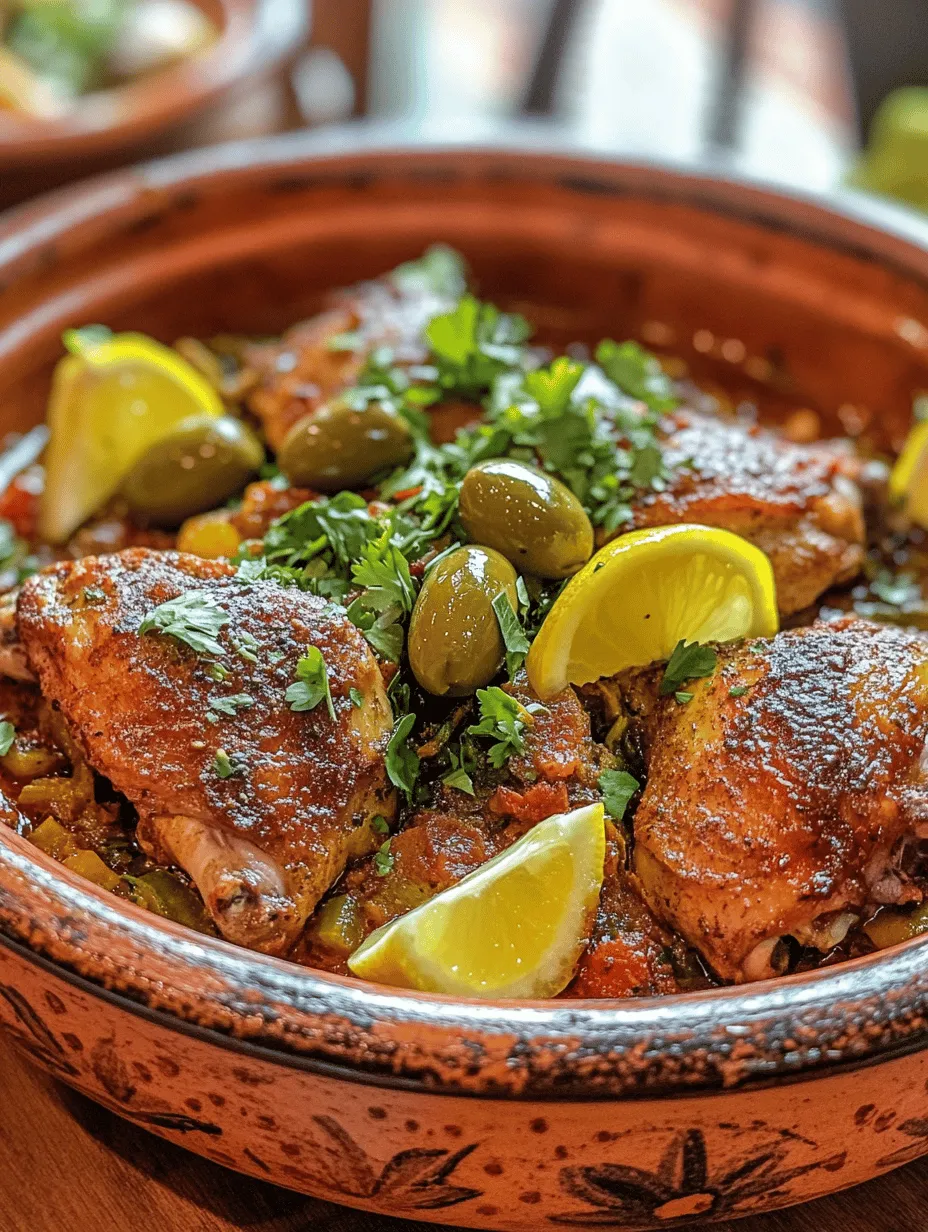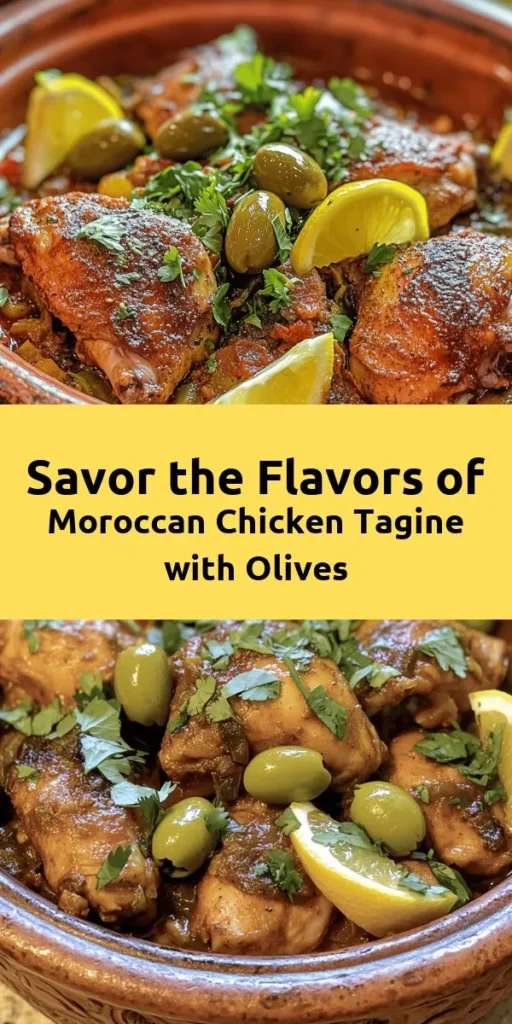Introduction
Moroccan Chicken Tagine with Olives and Lemons is not just a meal; it’s an invitation to experience the rich tapestry of Moroccan culture and culinary artistry. This iconic dish beautifully encapsulates the essence of Moroccan cooking, where vibrant flavors and aromatic spices come together in a comforting and satisfying way. With tender chicken, briny olives, and zesty lemons, each bite transports you to the bustling markets of Marrakech and the sun-soaked landscapes of the Moroccan countryside.
The tagine, a traditional cooking vessel with a conical lid, plays a crucial role in this dish. It creates a unique cooking environment that allows for the slow simmering of ingredients, resulting in a depth of flavor that is both complex and harmonious. Moroccan Chicken Tagine is often enjoyed during family gatherings and celebrations, making it an ideal dish for cozy dinners or festive occasions. Whether you are hosting friends or simply treating your family to a delightful meal, this dish promises to impress with its captivating aromas and flavors.
Understanding Tagine Cooking
To truly appreciate Moroccan Chicken Tagine with Olives and Lemons, one must understand the essence of tagine cooking. The term “tagine” refers both to the dish itself and the earthenware pot used to prepare it. Historically, tagines have been used in North African cuisine for centuries, allowing people to slowly cook their food over a low flame. This method not only tenderizes the meat but also allows for a wonderful melding of spices and flavors.
The unique design of the tagine pot contributes significantly to the cooking process. The conical lid traps steam, allowing condensation to collect and drip back into the dish, ensuring that the ingredients remain moist and flavorful. The slow cooking process is integral to Moroccan cuisine, as it allows the spices—such as cumin, coriander, and cinnamon—to fully infuse the meat and vegetables, creating a rich, aromatic sauce that is perfect for serving over fluffy couscous or crusty bread.
The art of tagine cooking also reflects the Moroccan way of life, where meals are often shared among family and friends, fostering connection and community. Preparing a tagine can be a communal activity, inviting others to participate in the cooking process, share stories, and savor the delightful aromas wafting through the kitchen.
Ingredients Breakdown
To create a flavorful Moroccan Chicken Tagine with Olives and Lemons, it is essential to select high-quality ingredients that each play a vital role in the dish. Here’s a comprehensive breakdown of the key components:
Chicken Thighs
Opting for bone-in, skin-on chicken thighs is crucial for achieving the best flavor and moisture in your tagine. The bones contribute to a richer broth, while the skin helps to keep the meat juicy during the cooking process. Chicken thighs are also more forgiving than chicken breasts, remaining tender and succulent even after extended cooking times.
Olive Oil
Using olive oil not only adds depth of flavor but also provides health benefits, including heart-healthy fats and antioxidants. It is the preferred oil in Moroccan cooking, enhancing the overall taste of the tagine. When selecting olive oil, choose a high-quality extra virgin variety for the best flavor.
Aromatics
Onions and garlic are the backbone of many Moroccan dishes, including this tagine. Sautéing these aromatics in olive oil builds a flavorful base that sets the stage for the spices and chicken. Onions add sweetness, while garlic provides a pungent depth that complements the other ingredients.
Spices
The magic of Moroccan Chicken Tagine lies in its array of spices. Each spice brings its own unique health benefits and flavor contributions:
– Ginger: Offers a warm, spicy note and is known for its anti-inflammatory properties.
– Cumin: Adds earthy warmth and aids digestion.
– Coriander: Provides a citrusy sweetness and is rich in antioxidants.
– Cinnamon: Infuses a subtle sweetness and has anti-inflammatory effects.
– Turmeric: Known for its vibrant color and health benefits, particularly its anti-inflammatory properties.
Chicken Broth
Chicken broth enriches the sauce, providing depth and a savory foundation. It enhances the flavors of the spices and allows the chicken to absorb the delicious essence of the tagine. For a richer flavor, consider using homemade broth if possible.
Olives and Lemons
Both olives and lemons are central to Moroccan cuisine, imparting a distinctive briny and tangy flavor to the dish. Green olives add a pop of saltiness, while preserved lemons bring a unique brightness and complexity. Preserved lemons, made by fermenting lemons in salt, are a staple in Moroccan cooking and contribute a depth of flavor that is unforgettable.
Fresh Cilantro
To finish the dish, fresh cilantro adds a burst of color and a refreshing herbaceous note. It balances the richness of the chicken and the depth of the spices, making it a perfect final touch.
Step-by-Step Cooking Instructions
Now that we have a solid understanding of the ingredients, it’s time to dive into the cooking process. Follow these detailed steps to create your Moroccan Chicken Tagine with Olives and Lemons:
Heating the Oil
Begin by selecting a sturdy, heavy-bottomed tagine pot or a Dutch oven. Place it over medium heat and add a generous amount of olive oil—approximately 2-3 tablespoons should suffice. As the oil heats up, it is crucial to monitor the temperature carefully; too high, and the oil may smoke or burn, while too low will not sear the chicken effectively.
Once the oil is shimmering but not smoking, it’s time to add the chicken thighs, skin-side down. Searing the chicken is an essential step that locks in moisture and develops a beautiful golden-brown crust. Allow the chicken to cook undisturbed for about 5-7 minutes, or until the skin is crispy and browned. Then, flip the thighs and cook for an additional 5 minutes on the other side.
After searing, remove the chicken from the pot and set it aside on a plate. This initial step not only enhances the flavor of the chicken but also creates fond at the bottom of the pot, which will add richness to the finished dish.
Sautéing Aromatics
With the chicken removed, it’s time to build the flavor base. In the same pot, add the chopped onions and sauté them in the remaining olive oil over medium heat. Cook the onions until they become translucent and start to caramelize, about 5-7 minutes. Stir occasionally to prevent sticking.
Once the onions are softened, add minced garlic and sauté for an additional minute, allowing the garlic to release its fragrant aroma. This combination of onions and garlic serves as the flavorful foundation for your tagine.
Adding the Spices
Next, it’s time to introduce the spices. Sprinkle in the ginger, cumin, coriander, cinnamon, and turmeric, stirring well to coat the onions and garlic. Allow the spices to toast for about 1-2 minutes, stirring frequently. This step is critical, as it releases the essential oils in the spices, intensifying their flavors and aroma.
Incorporating the Chicken Broth
After the spices have bloomed, pour in the chicken broth, scraping the bottom of the pot to deglaze and incorporate the flavorful fond into the liquid. Stir to combine, and bring the mixture to a gentle simmer.
Returning the Chicken
Once the broth is simmering, return the seared chicken thighs to the pot, nestling them into the flavorful liquid. The chicken should be partially submerged in the broth, allowing it to absorb all the delicious flavors as it cooks.
Adding Olives and Lemons
Finally, it’s time to add the olives and preserved lemons. If you are using fresh lemons, slice them thinly and add them to the pot along with the olives. Stir gently to combine, ensuring that the chicken is surrounded by the olives and lemons.
At this point, you can also cover the tagine with its lid or, if using a Dutch oven, cover it with a tight-fitting lid. Reduce the heat to low and let the tagine simmer gently for about 30-40 minutes, or until the chicken is cooked through and tender. The slow cooking process allows the flavors to meld beautifully, creating a fragrant and savory sauce.
As the tagine simmers, the enticing aromas will fill your kitchen, creating an atmosphere of warmth and comfort that is synonymous with Moroccan cooking.
In the next section, we will explore additional steps and tips to ensure that your Moroccan Chicken Tagine with Olives and Lemons turns out perfectly every time, along with common questions and troubleshooting advice to enhance your cooking experience. Stay tuned for more delicious insights!

Browning the Chicken
Achieving a golden-brown crust on the chicken is a pivotal step in preparing Moroccan Chicken Tagine with Olives and Lemons. This process not only enhances the visual appeal of the dish but also develops a rich depth of flavor through the Maillard reaction. To achieve this, start by patting the chicken pieces dry with paper towels; moisture on the surface can prevent proper browning. Heat a tablespoon of olive oil in your tagine or a heavy-bottomed pot over medium-high heat. Once the oil is shimmering, carefully add the chicken pieces skin-side down, ensuring they are not overcrowded.
Allow the chicken to sear undisturbed for about 5-7 minutes until a golden crust forms. Flip the pieces and repeat on the other side. This initial browning creates a savory base that will infuse subsequent ingredients with flavor, ensuring your tagine is aromatic and delicious. Once browned, remove the chicken from the pot and set it aside, allowing the remaining juices to create a flavor-packed foundation for the rest of the dish.
Sautéing Aromatics
With the chicken set aside, it’s time to develop the dish’s aromatic base. In the same pot, reduce the heat to medium and add finely chopped onions, garlic, and ginger. Sauté these ingredients for about 5-7 minutes, stirring frequently, until the onions become translucent and fragrant. This step is crucial as it builds layers of flavor that will permeate the entire dish.
Next, it’s time to add the spices. Sprinkle in your ground cumin, coriander, cinnamon, turmeric, and a pinch of cayenne pepper. Stir these spices into the onion mixture and sauté for an additional 2-3 minutes. Timing is essential here; adding spices too early can result in burning, while adding them too late can prevent their essential oils from releasing, which are key to the dish’s flavor profile. The goal is to create a fragrant concoction that sets the stage for the remaining ingredients.
Adding Broth and Lemons
Once your aromatics are beautifully sautéed, it’s time to build the sauce by adding chicken broth and the star of the dish—lemons. Pour in about 2 cups of low-sodium chicken broth, scraping the bottom of the pot to release any browned bits. This step enhances the flavor as it incorporates all those delicious morsels into the broth.
Next, add your preserved lemons, which contribute a unique tanginess that is characteristic of Moroccan cuisine. If you can’t find preserved lemons, you can substitute with fresh lemon juice and zest, but the flavor will differ slightly. Stir the mixture well, ensuring the broth and lemons are evenly distributed. The acidity from the lemons will balance the richness of the chicken and the spices, creating a harmonious flavor that’s integral to this tagine.
Returning Chicken to Pot
After the broth and lemons are well combined, it’s time to return the chicken to the pot. Nestle the browned chicken pieces back into the mixture, ensuring they are mostly submerged in the aromatic broth. This step is critical for even cooking; keeping the chicken submerged helps to tenderize the meat and allows it to absorb the flavors of the spices and broth.
Bring the mixture to a gentle simmer, then reduce the heat to low. Cover the pot with a lid, allowing the chicken to cook slowly and evenly. The slow cooking method is the secret to achieving tender, succulent chicken that practically falls off the bone.
Slow Cooking
Slow cooking is not just a technique; it’s an art form that transforms ordinary ingredients into extraordinary meals. As the chicken simmers in the broth, the low heat breaks down the collagen in the meat, resulting in a tender texture that pairs beautifully with the rich, spiced sauce. This process typically takes about 45 minutes to 1 hour, depending on the size of your chicken pieces.
During this time, resist the urge to lift the lid too often. Each time you do, heat escapes, potentially elongating the cooking time. Instead, take this opportunity to prepare your sides or set the table, letting the flavors meld together seamlessly.
Adding Olives
After the chicken has cooked low and slow, it’s time to add the olives. Generally, you should add them during the last 15 minutes of cooking to prevent them from becoming overly soft and mushy. The olives contribute a briny contrast that balances the dish and enhances its complexity.
Stir in about a cup of green olives—preferably Moroccan or Castelvetrano olives for their rich, buttery flavor. Allow the olives to heat through while absorbing the aromatic sauce. This final touch elevates the dish, tying all the flavors together beautifully.
Garnishing and Serving
Once the chicken is tender and the olives are warmed, it’s time to plate your Moroccan Chicken Tagine with Olives and Lemons. Consider serving the tagine directly from the pot for a rustic presentation that encourages sharing. Garnish with fresh cilantro or parsley for a pop of color and freshness.
Traditionally, this dish pairs beautifully with fluffy couscous, which soaks up the flavorful sauce. Alternatively, serve it with crusty bread for dipping or over steamed rice for a satisfying meal. For a complete Moroccan experience, consider offering a simple side salad made with cucumber, tomatoes, and a light vinaigrette to balance the richness of the tagine.
Cultural Significance of Moroccan Cuisine
Moroccan cuisine is a tapestry woven from various cultural influences, including Berber, Arab, and Mediterranean traditions. Each dish tells a story, reflecting the country’s rich history and diverse geography. Moroccan Chicken Tagine with Olives and Lemons is not just a meal; it embodies the warmth and hospitality that Moroccan culture is known for.
Typically, tagines are enjoyed during family gatherings and celebrations, symbolizing unity and togetherness. The slow-cooked nature of the dish encourages conversation and shared experiences, making it a staple in both home kitchens and restaurants across Morocco. The vibrant flavors and aromatic spices make Moroccan cuisine appealing worldwide, transforming meals into cultural experiences.
Nutritional Aspects
Moroccan Chicken Tagine is not only flavorful but also nutritious. The dish is rich in protein from the chicken, providing essential amino acids necessary for muscle repair and overall health. The use of healthy fats from olive oil not only enhances flavor but also supports heart health.
The abundance of vegetables used in this recipe, from onions to preserved lemons, contributes vitamins and minerals essential for a balanced diet. Spices like turmeric and ginger not only add flavor but also boast anti-inflammatory properties, making this dish not just a feast for the palate but also for health-conscious eaters.
When served with couscous or a fresh salad, this dish can fit seamlessly into a well-rounded diet, offering a delightful balance of proteins, healthy fats, and complex carbohydrates.
Pairing Suggestions
To enhance your dining experience with Moroccan Chicken Tagine, consider traditional accompaniments that complement the dish’s rich flavors. Fluffy couscous is a classic side that pairs well, soaking up the delicious sauce and providing a satisfying texture. Alternatively, serve the tagine over rice or with crusty bread to catch every drop of the flavorful broth.
For side dishes, consider a refreshing Moroccan salad made with diced cucumbers, tomatoes, and parsley, drizzled with a lemon vinaigrette. Roasted or grilled vegetables seasoned with Moroccan spices can also elevate the meal and add another layer of flavor.
When it comes to beverages, a glass of Moroccan mint tea is a traditional choice, offering a refreshing and sweet contrast to the savory dish. For those who prefer wine, a light, fruity white or a rosé can complement the spices without overwhelming the palate.
Conclusion
Moroccan Chicken Tagine with Olives and Lemons is more than just a dish; it’s a celebration of flavors and culture that brings families and friends together around the table. The comforting combination of tender chicken, aromatic spices, and the tangy brightness of preserved lemons makes this tagine a standout in any culinary repertoire.
Encouraging exploration into the vibrant world of Moroccan cuisine, this recipe invites you to experience a journey of flavors that is both delightful and nourishing. Whether you are cooking for a special occasion or a cozy weeknight dinner, this dish promises to deliver warmth and comfort while celebrating the rich traditions of Moroccan cooking. Dive into this recipe, and you may just find a new favorite that will become a staple in your home, fostering connections and creating delicious memories.



